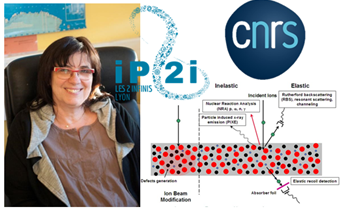NOMATEN HYBRID-SEMINAR March 21: Study of He and Li diffusion in B4C – Role of damage
Online: https://www.gotomeet.me/NCBJmeetings/nomaten-seminar
In-person: NOMATEN seminar room
NOMATEN HYBRID-SEMINAR
online: https://www.gotomeet.me/NCBJmeetings/nomaten-seminar
In-person: NOMATEN seminar room
Tuesday, MARCH 21st 2023 13:00 CET
Study of He and Li diffusion in B4C – Role of damage
N. Moncoffre1, M. Bousseksou2, D. Gosset3, G. Gutierrez2, V. Motte3, Y. Pipon1, T. Sauvage4
1IP2I, CNRS IN2P3 et Université Lyon 1, Villeurbanne, France
2Université Paris-Saclay, CEA, Service de Recherche en Corrosion et Comportement des Matériaux, SRMP, Gif Sur Yvette, France
3Université Paris-Saclay, CEA, Service de Recherche en Matériaux et procédés Avancés, Gif Sur Yvette, France
4CNRS CEMHTI Orléans, France
Abstract:
In the context of fast neutron reactors, boron carbide is a ceramic material with excellent properties for controlling nuclear reactor power. Thanks to its high absorption cross sections of 10B, this material provides an excellent neutron absorber. As a consequence of the 10B(n,α) nuclear reactions, significant quantities of helium and lithium are produced (up to about 1022 cm-3), that modify significantly the chemical and structural composition of the initial material. We will discuss the diffusion behaviour of these light elements through a fundamental approach that uses ion beams. The two isotopes 3He (to simulate 4He) and 7Li were introduced by ion implantation using the ion implanter of the SCALP Orsay facility at IJCLab (Paris-Saclay University, France) at depths ranging between 0.6 and 1.3 μm in sintered B4C pellets of different grain sizes and with maximum atomic concentrations at range maximum in between 0.03 and 3%. Au post-irradiation experiments performed at the JANNuS Saclay facility, were used to create ballistic damage in a control way. The isotope distribution profiles were determined before and after thermal annealing in the 500-1000°C temperature range by using either the 3He (2H, 4He)1H nuclear reaction or Secondary Ion Mass spectrometry (SIMS). These two techniques, thanks to their excellent depth resolution, allow determining apparent diffusion coefficients through the evolution of the profiles, and estimating activation energy values from the Arrhenius law. Raman spectroscopy analysis allows to evaluate the disorder recovery of the material in the various steps. The behaviour of these elements in B4C will be shown. Concerning He diffusion, it is shown that the He bubble nucleation is enhanced by the irradiation induced-defects that trap helium atoms. Lithium thermal diffusion appears heterogeneous as a function of depth up to a given concentration threshold which suggests the formation of complexes that trap lithium.
The different diffusion and trapping mechanisms as a function of the implanted ions, as well as the implantation and annealing conditions and the material grain size will be discussed with respect to the ballistic damage.
Bio:
Dr. Moncoffre, a Senior Scientist at the CNRS (National Center for Scientific Research), has been a CNRS Researcher since 1986. Currently based at the IP2I (Institute of the 2 Infinites), a joint research unit of CNRS/IN2P3 and Claude Bernard University in Lyon, France, Dr. Moncoffre is an expert in the experimental simulation of nuclear materials in reactor or storage conditions using ion beams. Dr. Moncoffre's academic background includes a PhD from Claude Bernard Lyon 1 University in 1986, focusing on the effects of nitrogen implantation into steels to improve their mechanical properties. In 1995, Dr. [Name] received a « Habilitation à Diriger des Recherches » diploma. She has supervised 18 PhD theses and co-supervised 6 others. Additionally, Dr. [Name] has authored 152 publications in peer-reviewed international scientific journals.
As the team leader of the MATICE (Materials in Extreme Conditions) research group, Energy Pole at IP2I, She is responsible for the study of the modification of nuclear materials by ion irradiation in a large range of energy, including ballistic damage and electronic excitation. Dr. [Name] is also the head of the French EMIR&A network, which comprises 15 ion and electron accelerators for irradiation and analysis. Moreover, Dr. Moncoffre serves as the head of the “Open University” at Lyon 1 University and is a member of several scientific committees, including the New AGLAE - CNRS Federation, Marcoule Institute in Separation Chemistry, and GANIL (Grand Accélérateur National d’ions lourds) in Caen. Dr. [Name] is also an intensive Erasmus Program coordinator and provides expertise for French ANR projects and European projects.
She's research fields include the study of diffusion mechanisms of mimics of fission products, the role of irradiation and temperature, radiolysis effects at the interface solid/solution, and the elemental analysis of nuclear materials (ceramics, oxides, carbides, graphite, steels) using ion beam analysis and physicochemical characterization. Dr. Moncoffre's key areas of expertise include irradiation, ion-matter interactions, implantation, radiolysis at interfaces, diffusion, nuclear materials, and radiation chemistry. She is also a member of the Advisory Editorial Board of Nuclear Instruments and Meth. in Phys. Res. B (Elsevier) and a steering group member of the SCINEE (Nuclear Science for Energy and Environment) CNRS research group.










